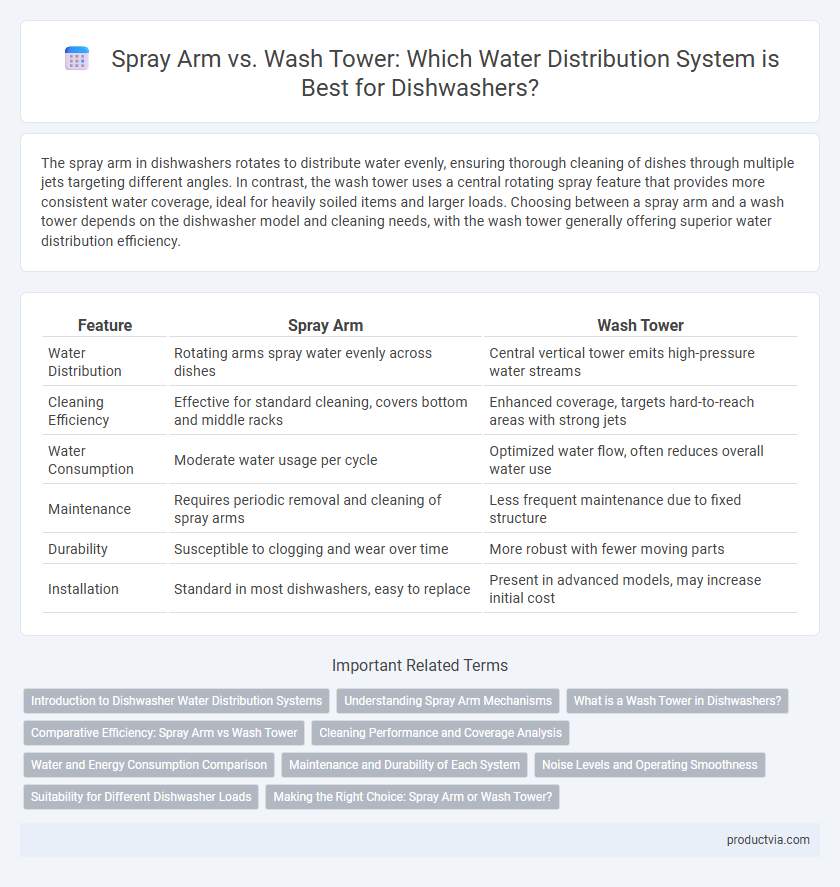The spray arm in dishwashers rotates to distribute water evenly, ensuring thorough cleaning of dishes through multiple jets targeting different angles. In contrast, the wash tower uses a central rotating spray feature that provides more consistent water coverage, ideal for heavily soiled items and larger loads. Choosing between a spray arm and a wash tower depends on the dishwasher model and cleaning needs, with the wash tower generally offering superior water distribution efficiency.
Table of Comparison
| Feature | Spray Arm | Wash Tower |
|---|---|---|
| Water Distribution | Rotating arms spray water evenly across dishes | Central vertical tower emits high-pressure water streams |
| Cleaning Efficiency | Effective for standard cleaning, covers bottom and middle racks | Enhanced coverage, targets hard-to-reach areas with strong jets |
| Water Consumption | Moderate water usage per cycle | Optimized water flow, often reduces overall water use |
| Maintenance | Requires periodic removal and cleaning of spray arms | Less frequent maintenance due to fixed structure |
| Durability | Susceptible to clogging and wear over time | More robust with fewer moving parts |
| Installation | Standard in most dishwashers, easy to replace | Present in advanced models, may increase initial cost |
Introduction to Dishwasher Water Distribution Systems
Dishwasher water distribution systems primarily utilize spray arms or wash towers to effectively circulate water and detergent throughout the interior. Spray arms, located at the bottom and sometimes the top, rotate to distribute water in targeted jets, ensuring thorough cleaning of dishes. Wash towers offer a centralized water distribution system, often providing enhanced reach and coverage by using multiple nozzles to spray water upward and outward for comprehensive cleaning performance.
Understanding Spray Arm Mechanisms
Spray arms in dishwashers rotate to distribute water evenly, using strategically placed nozzles that create high-pressure jets to remove food debris effectively. These mechanisms vary in design, with single or multiple spray arms positioned at the base, middle, or top of the dishwasher to target different rack areas for enhanced cleaning coverage. Understanding the spray arm's rotation speed, nozzle placement, and water pressure is crucial for optimizing water distribution and improving overall dishwasher performance.
What is a Wash Tower in Dishwashers?
A wash tower in dishwashers is a vertical water distribution system designed to deliver a powerful and consistent spray across all rack levels. Unlike traditional spray arms that rotate at the base, the wash tower extends vertically with multiple spray nozzles, ensuring better coverage and effective cleaning of dishes. This innovative design enhances water circulation and improves overall washing performance, especially in larger or heavily loaded dishwashers.
Comparative Efficiency: Spray Arm vs Wash Tower
Spray arms deliver targeted jets of water that rotate to ensure thorough coverage and efficient cleaning, while wash towers generate vertical water movement providing consistent water pressure across all rack levels. Spray arms tend to perform better in reaching tight spaces and provide more intense cleaning on heavily soiled dishes. Wash towers, however, excel in evenly distributing water for larger loads, reducing water consumption while maintaining effective cleaning performance.
Cleaning Performance and Coverage Analysis
Spray arms in dishwashers provide targeted water jets that ensure precise cleaning by reaching various angles of the dish racks, optimizing soil removal on individual items. Wash towers distribute water through multiple nozzles positioned vertically, offering broader coverage that effectively cleans dishes stacked at different levels, enhancing overall performance. Comparative analysis indicates wash towers excel in comprehensive coverage but may consume more water, whereas spray arms deliver focused cleaning with efficient water usage.
Water and Energy Consumption Comparison
Spray arms in dishwashers typically use focused jets of water that target specific areas, resulting in efficient water use and moderate energy consumption due to shorter cycles. Wash towers distribute water through multiple nozzles, enhancing coverage but often increasing water volume and energy use as longer or more intense cycles are needed for thorough cleaning. Studies indicate spray arms generally consume 10-20% less water and energy compared to wash towers, making them a preferred choice for energy-conscious users.
Maintenance and Durability of Each System
Spray arms in dishwashers typically require routine cleaning to prevent clogging from food particles and mineral buildup, affecting water distribution and longevity. Wash towers offer more robust construction with fewer moving parts, enhancing durability and reducing maintenance frequency but may be harder to service if issues arise. Both systems demand regular inspection, but wash towers generally provide longer-lasting performance under heavy usage conditions.
Noise Levels and Operating Smoothness
Spray arms typically produce lower noise levels due to their simpler rotation mechanisms, resulting in quieter dishwasher operation compared to wash towers, which use multiple jets and can create more turbulent water flow. Wash towers enhance water distribution efficiency but may generate higher noise and vibration due to their complex design and higher pressure water streams. Smooth operation in dishwashers is more commonly associated with spray arms, which have fewer moving parts and maintain consistent rotation, whereas wash towers might experience increased mechanical noise from their intricate water delivery system.
Suitability for Different Dishwasher Loads
Spray arms provide targeted water jets ideal for standard and moderately soiled dishwasher loads, ensuring efficient cleaning of dishes positioned at various angles. Wash towers, featuring multiple spray levels and rotating nozzles, deliver comprehensive water coverage suited for heavily soiled or densely packed loads. Choosing between spray arms and wash towers depends on the typical load size and soil level, optimizing water distribution and cleaning performance.
Making the Right Choice: Spray Arm or Wash Tower?
Choosing between a spray arm and a wash tower in dishwasher water distribution impacts cleaning efficiency and coverage. Spray arms rotate and deliver targeted water jets, ideal for thorough cleaning of pots and dishes with varied angles. In contrast, wash towers offer powerful, multi-level water distribution with simultaneous jets, enhancing coverage in compact dishwashers or those with dense loading.
Spray arm vs Wash tower for water distribution in dishwashers Infographic

 productvia.com
productvia.com